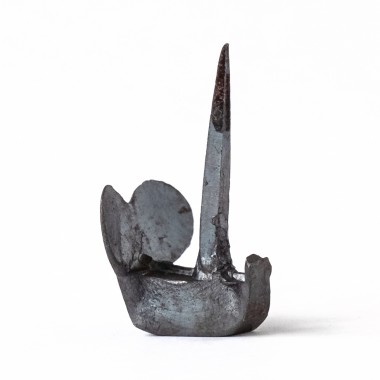Description
Original spikes (nails) for German mountain military shoes from the Second World War. Made in Germany before the war. Spikes steel, rust-free, from the original packaging of the 1940s.
Designed for the German model of mountain boots (for rangers). They have 3 options:
1) on the sole (with a conical head); for 1 pair of shoes you need 50-72 pcs. depending on the padding pattern (and shoe size).
2) on the welt (on the edge of the sole, the shape like the head of Mickey Mouse, the short spike), for 1 pair of shoes of size 43 you need 42 pcs. The number of fittings depends on the size of the shoe: it is obvious that the perimeter of the soles of sizes 40 and 46 are different. That is, the number of spikes for the welt can be from 34 to 56 pcs.
3) on the heel (on the edge of the heel, the shape like “Mickey Mouse head”, the long spike); for 1 pair of shoes of size 43 you need 50 pcs., but for large sizes or with dense installation pattern it can reach up to 58 pcs.
Price for 1 nail of any kind.
Historical reference.
At a time when soles of rubber and plastic were not invented, the soles were made of dense cow skin and executed with iron metal cleats. Shoes have been made this way since ancient times. Nails, cleats provided good adhesion to most surfaces in the field, except for smooth stone and ice. If the ice was soft, then iron-finished boots kneaded it and provided traction. For a long walk on the ice, climbers had special equipment — crampons.
These metal parts for shoues inherited their name Triconi from the Swiss company Tricouni, which has been producing them since 1912 for mountain walks and alpinism. Equipped with iron mountain boots were prevalent in the first half of the XX century, not only in German mountain rifle units. Swiss, German, Austrian, Italian armies had own model. Every country with extensive passable mountains had it. Also, the USSR had its own model of mountain boots with iron on soles, and similar models were produced until the end of the XX century.


Sole of German mountain boots: early and late (on the right/bottom) models; sizes 29 and 28, respectively. Photo from fjm44.com.
In the German army, boots were adapted for use with skis. There were special plates (usually brass) on the sides of the sole in the front, which by the end of the war had become the same spikes as others, but with a wide, flat side.
On the bottom of the heel, the spikes were installed in the shape of a diamond with a side of 3 spikes. Inside the "diamond" there could be 1 spike (on small sizes) or 4 spikes (on large). On the bottom of the sole, the diamond had usually 5 spikes on each side, but on a small size it was only 4 spikes per side. Also, the heel could be beaten tightly around the edge with spikes, or they could make a pass on the back inside, or they could even install spikes with gaps like on the sole...

The soldier with the clearly small foot, judging by the number of iron parts on the sole. An “economical” installation method on the heel is also interesting. Photo from the Bundesarchive taken from the site ru.wikipedia.org.
Clother to the end of the war, a genearl issue model of boots appeared for Heer, where the heel had the same triconis as on mountain boots.



















![[on order] German high-boots 35 cm "shark nose" 1939-45 [on order] German high-boots 35 cm "shark nose" 1939-45](https://reenact.store/image/cache/f1bff9f91f7c6e957c5e86c870ed6d17.jpg)











![[on order] German ankle-boots M37 [on order] German ankle-boots M37](https://reenact.store/image/cache/5667337da7ed6f7b7950a1450463c17e.jpg)
![[on order] German ankle-boots M37 with rubber sole [on order] German ankle-boots M37 with rubber sole](https://reenact.store/image/cache/44907145bd93add03529e77571283a85.jpg)
![[on order] German shoes for field camp [on order] German shoes for field camp](https://reenact.store/image/cache/08fc68850f974fcd552cca26fdfea7b7.jpg)
![[on order] High-boots tightening strap [on order] High-boots tightening strap](https://reenact.store/image/cache/d263618c1781731a1aefc361c4ad28c0.jpg)


![[on order] German ankle-boots M37 variant 2 [on order] German ankle-boots M37 variant 2](https://reenact.store/image/cache/f03919d9f1aeb10c9fe66f8370adae05.jpg)

